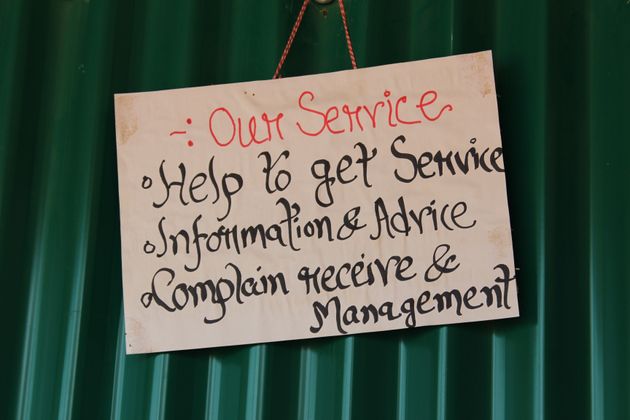I was exhausted. It had been a great week in Bangladesh, but the overload of language, smells, refugee camps, seeing old friends, meeting new friends, government, donors, and all the while pretending like I wasn’t jet-lagged, was taking its toll. I just wanted to go to sleep.
My last meeting was in Dhaka with someone in the Prime Minister’s office. I had little hope of staying awake through the meeting.
And yet, I was captivated.

The literacy rate in Bangladesh is considered low (72.8 percent according to UNESCO in 2016), but is just below the global average. Literacy among women is lower (69.9 percent) but, in general, the majority of the people have at least basic literacy skills. There is 90 percent mobile phone penetration and 96 percent mobile internet access. The International Mother Language Institute, the body in Bangladesh that supports the promotion, spread, and preservation of Bangla languages, says that 41 languages are spoken in the country, only five of which have written scripts. In the humanitarian response for Rohingya refugees in Cox’s Bazar, Translators without Borders (TWB) finds the situation particularly difficult. Rohingya has no agreed written script. Very few of the refugees can read and write, there are few people who speak Rohingya and anything else well. Add to this mix low radio coverage – not only do the Rohingya not have radios, even if they did there is not even radio coverage in parts of the camps – and about one million people living in poor and difficult conditions that speak many different dialects and you begin to understand why communicating effectively is difficult.
It’s vitally important that there is two-way communication between the people – refugees and local Bangladeshis – and the government and aid workers. Take the issue of the coming monsoon. Formal and makeshift refugee camps have sprouted up all over the Cox’s Bazar district, an area that includes a national park and lush forest. But now the trees have been torn down to make room for shelters and for firewood. This makes the soil very unstable and dangerous, with monsoon rains promising huge mud pits and the possibility of landslides. It is also a hilly area; tents are built on the sides of hills that will become slippery and unstable with heavy rains and wind. Refugees as well as local residents need to know where to go, what to do if there’s an emergency, how to get help for those needing medical attention, and what to do if food gets swept away.
The challenges abound. The digital world seems a world away.
And yet, enter Dr. Jami. In a buzzy, busy office with a high level of excitement and a relatively good gender balance, I was suddenly in the middle of a high-tech environment. Dr. Jami launched directly into what he wanted us to know and do.
Dr. Jami runs the Access to Information (A2I, inevitably) project in the Prime Minister’s office. The aim is to help the people of Bangladesh quickly and easily get information on public services. One of A2I’s projects is the digitisation of government institutions; they have developed over 1,000 key government websites. Dr. Jami is not a language guy (he’s a solutions architect), but he proceeds to tell me quickly that Bangla was only standardised in Unicode five years ago, so there is very little data available from which to build good translation engines. While there’s 90 percent mobile phone penetration, in 2018 GSMA estimated that only 28-30 percent of those were smartphones. Yet, 96 percent of internet access is via phones. Whaaa? How does that work? It’s also startling how little desktops and laptops are used to access the internet.
I asked a taxi driver, who was using a smartphone, if he used his phone for the internet. He replied, “No, but I use it for Facebook.”
There are no data charges for Facebook in Bangladesh – unless you want to view videos or pictures. Internet use is Facebook and Facebook is only text. Those who are illiterate, or only barely literate, won’t have smartphones.
To Dr. Jami, who needs more people to have smartphones to help ensure they can get access to information, cost is not the barrier: There are very inexpensive smartphones in Bangladesh. He believes it is fear of technology, which he believes is associated with illiteracy. To reach his goal of migrating 70 percent of the current mobile phone users to smartphones, he must address fear.
Language is an issue. With a population of over 157 million people, and one of the most spoken languages in the world, you’d think that the language technology for Bangla would be outstanding. It’s not. That’s surprising. And without that technology, equipping 1,000 websites with dynamic information in Bangla is nearly impossible, not to mention making them interactive and/or adding audio.
The work that A2I is doing is globally relevant, of course. Other countries are already seeking their support to bring better access to information to their people. He mentions that they are already working in South Sudan – which has the second lowest literacy rates in the world. Again, the language barrier is huge. And, again, there is little digital language data.
Dr. Jami has heard of TWB’s Gamayun project – can we help? Can we be a neutral broker to bring together the limited language data out there and leverage our knowledge of language and the language industry to help Bangladeshis get access to information about basic services?
Dr. Jami and the TWB team will continue this conversation – there are still many questions to be asked and answered. But I was impressed by the enthusiasm and the accomplishments of his team. And I am really excited to see where Dr. Jami and other countries take this exciting initiative.